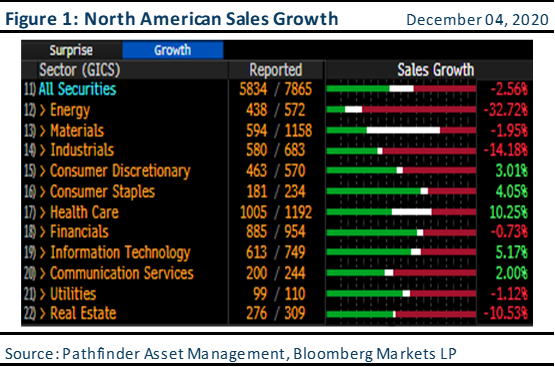Earnings Season comes to a close
As regular readers of the Pathfinder Investment Outlook know, our writing follows the calendar of quarterly earnings reports. The companies that we invest in report financial data and management commentary on a regular basis, which is colloquially called “earnings season”. This is an important part of our investment process because we are able to check the progress of the companies that we own, as well as management’s expectations for the future for the firm.
The end of earnings season in Canada traditionally comes when the banks report, which happened this past week. Generally, we were pleasantly surprised by the results of the Canadian banks. We expected that, given the current economic situation, their results would have been more negative but it appears that loan operations have been performing better than both investors and management had expected. Banks take reserves against income if their clients are potentially not able to pay back their loans. While there were large reserves taken at the beginning of the pandemic, the actual performance of the loan portfolio has been much better than expected. This is positive for the banks and a constructive indicator for the Canadian economy. One area that continues to remain difficult, however, is the net interest margin. At a high level, this is the difference between what banks can charge clients for loans and what they pay clients for depositing cash in their accounts. As many of you are aware, interest rates are at historic lows, so the margin between the two has been compressed, which has made it harder for all banks to earn a profit.
- Figure 1 presents sales data for all North American companies for the third quarter of this year. As of today, 74% of companies have reported and aggregate sales have dropped 2.6%., This is the third quarter in a row with negative sales growth.

- As you can see, the consumer, health care and technology sectors continue to remain the only bright parts of the economy. Industry and real estate continue to struggle.
“This means that” while the stock market continues to reach new highs and we are hopeful that the end of pandemic is months and not years away, there is significant damage to the real economy. We will continue to pay special attention to these topics as we are far from being back to normal.
This will be our last edition of the Pathfinder Investment Outlook for 2020. We will spend he the rest of year writing our mandate reviews and investment outlooks. You can expect Volume 11 to begin January 8th, 2021.
National Instrument 31-103 requires registered firms to disclose information that a reasonable investor would expect to know, including any material conflicts with the firm or its representatives. Doug Johnson and/or Pathfinder Asset Management Limited are an insider of companies periodically mentioned in this report. Please visit www.paml.ca for full disclosures.
*All returns are time weighted and net of investment management fees. Returns from the Pathfinder Partners’ Fund and Pathfinder Real Fund are presented based on the masters series of each fund. The Pathfinder North American Equity Portfolio and The Pathfinder North American Income Portfolio are live accounts. These are actual accounts owned by the Pathfinder Chairman (Equity) and client (High Income) which contain no legacy positions, cash flows or other Pathfinder investment mandates or products. Monthly inception dates for each fund and portfolio are as follows: Pathfinder North American Equity Portfolio (January 2011), Pathfinder North American High-Income Portfolio (October 2012) Pathfinder Partners’ Fund (April 2011), Pathfinder Real Fund (April, 2013), and Pathfinder International Fund (November 2014).
Pathfinder Asset Management Limited (PAML) and its affiliates may collectively beneficially own in excess of 10% of one or more classes of the issued and outstanding equity securities mentioned in this newsletter. This publication is intended only to convey information. It is not to be construed as an investment guide or as an offer or solicitation of an offer to buy or sell any of the securities mentioned in it. The author has taken all usual and reasonable precautions to determine that the information contained in this publication has been obtained from sources believed to be reliable and that the procedures used to summarize and analyze such information are based on approved practices and principles in the investment industry. However, the market forces underlying investment value are subject to sudden and dramatic changes and data availability varies from one moment to the next. Consequently, neither the author nor PAML can make any warranty as to the accuracy or completeness of information, analysis or views contained in this publication or their usefulness or suitability in any particular circumstance. You should not undertake any investment or portfolio assessment or other transaction on the basis of this publication, but should first consult your portfolio manager, who can assess all relevant particulars of any proposed investment or transaction. PAML and the author accept no liability of any kind whatsoever or any damages or losses incurred by you as a result of reliance upon or use of this publication.